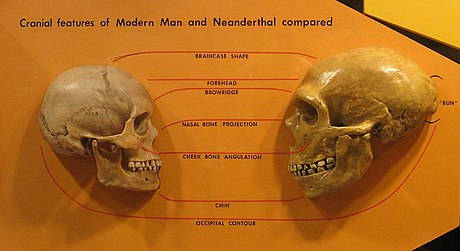User:Ems57fcva/sandbox/Homo sapiens
| This is not a Wikipedia article: This is a workpage, a collection of material and work in progress that may or may not be incorporated into an article. It should not necessarily be considered factual or authoritative. |
- This article is about Homo sapiens as a taxonomic species. For a more general perspective on mankind, see human.
| Homo Sapiens Temporal range: Pleistocene - Recent
| |
|---|---|

| |
| Human male and female | |
| Scientific classification | |
| Kingdom: | |
| Phylum: | |
| Class: | |
| Order: | |
| Family: | |
| Subfamily: | |
| Tribe: | |
| Subtribe: | |
| Genus: | |
| Species: | H. sapiens
|
| Binomial name | |
| Homo sapiens Linnaeus, 1758
| |
| Subspecies | |
Homo sapiens is the binomial name for the taxonomic species of the human world population. The species is usually taken to have emerged out of a predecessor within the Homo genus around 200,000 years ago, but there is no universal consensus on terminology, and some scholars include humans of up to 600,000 years ago under the same species.
There are two commonly recognized subspecies, Homo sapiens sapiens, which includes all humans alive today, and Homo sapiens idaltu, based on fossil evidence of about 160,000 years ago.
The term Anatomically modern human (AMH) in paleoanthropology refers to early individuals of Homo sapiens with an appearance consistent with the range of phenotypes in modern humans. Anatomically modern humans evolved from archaic Homo sapiens in the Middle Paleolithic, about 200,000 years ago. The emergence of anatomically modern human marks the dawn of the subspecies Homo sapiens sapiens, i.e. the subspecies of Homo sapiens that includes all modern humans.
The designation Homo sapiens was introduced by Carl Linnaeus in 1758 in the 10th edition of his Systema Naturae, and referred only to modern humans. As fossil specimens which are related to modern humans in varying degrees came to be discovered, controversy arose over just what the designation Homo sapiens should include. In the mid-to-late 20th century, Homo sapiens was often taken to include the Neanderthals and archaic Homo sapiens. More modern treatments limit this designation to living humans (Homo sapiens sapiens) and Homo sapiens idaltu.
Subdivisions
[edit]The following table illustrates the relationship between the broader and narrower views of the scope of Homo sapiens.
| Grouping | Designation | |
|---|---|---|
| Under Homo sapiens | as seperate species | |
| Anatomically modern humans | Homo sapiens sapiens | Homo sapiens |
| Homo sapiens idaltu | ||
| Neanderthals | Homo sapiens neanderthalis | Homo neanderthalis |
| Archaic Homo sapiens | Homo sapiens heidelbergensis | Homo heidelbergensis |
| Homo sapiens rhodesiensis | Homo rhodesiensis | |
| Homo sapiens antecessor | Homo antecessor | |
| Denisova hominin? | ||
Anatomy
[edit]
Anatomically modern humans are distinguished from their immediate ancestors, archaic Homo sapiens, by a number of anatomical features. Archaic Homo sapiens had robust skeletons, indicating that they lived a physically demanding life; this may mean that anatomically modern humans, with their more gracile frames, had become more dependent on technology than on raw physical power to meet the challenges of their environment. Archaic Homo sapiens also had very prominent brow ridges (protruding layers of bone above the eye socket). With the emergence of anatomically modern humans, the brow ridges had significantly reduced, and in modern humans they are, on average, barely visible. Another distinguishing feature of AMH is a prominent chin, something which is lacking in archaic Homo sapiens.
AMH also have a vertical forehead whereas their predecessors had foreheads that sloped backwards.[1] According to Desmond Morris, the vertical forehead in humans not only houses larger brains, but the prominent forehead plays an important role in human communication through eyebrow movements and forehead skin wrinkling.[2]
Fossils
[edit]The oldest fossil remains of anatomically modern humans are the Omo remains that date to 195,000 years ago. Other fossils include Homo sapiens idaltu from Herto in Ethiopia that are 150 kya and remains from Skhul in Israel that are 90,000 years old.

The Omo, Hertho, Skhul and Jebel Qafzeh remains are sometimes referred to as "Early Modern Humans" because their skeletal remains exhibit a mix of archaic and modern traits. Skhul V for example, has prominent brow ridges and a projecting face. However the brain case of Skhul V is distinct from that of the Neanderthals and is similar to the brain case of modern humans. In Europe, the early modern humans were the Cro-Magnon.
Behaviour
[edit]There is considerable debate regarding whether the earliest anatomically modern humans behaved similarly to recent or existing humans. Modern human behaviors characteristic of recent humans include fully modern language, the capacity for abstract thought and the use of symbolism to express cultural creativity. Some scholars argue that humans achieved anatomical modernity first, around 200kya, and only later did they adopt modern behaviors around 50kya. This hypothesis is based on the limited record of fossils from periods before 50kya and the abundance of human artifacts found after 50kya. Proponents of this view distinguish "anatomically modern humans" from "behaviorally modern humans".[3]
See also
[edit]References
[edit]- ^ "Encarta, Human Evolution". Archived from the original on 2009-10-31.
- ^ Desmond Morris (2007). "The Brow". The Naked Woman: A Study of the Female Body. ISBN 978-0312338534.
- ^ Mellars, Paul (2006). "Why did modern human populations disperse from Africa ca. 60,000 years ago?". Proceedings of the National Academy of Sciences. 103 (25): 9381–9386. doi:10.1073/pnas.0510792103. PMC 1480416. PMID 16772383.
External links
[edit]- EARLY AND LATE “ARCHAIC“HOMO SAPIENS AND “ANATOMICALLY MODERN” HOMO SAPIENS
- Origins of Modern Humans: Multiregional or Out of Africa?
- Homo sapiens - Museum of Natural History
Category:Recent single origin hypothesis Category:Human evolution Category:Humans Category:Middle Stone Age Category:Paleoanthropology Homo sapiens
